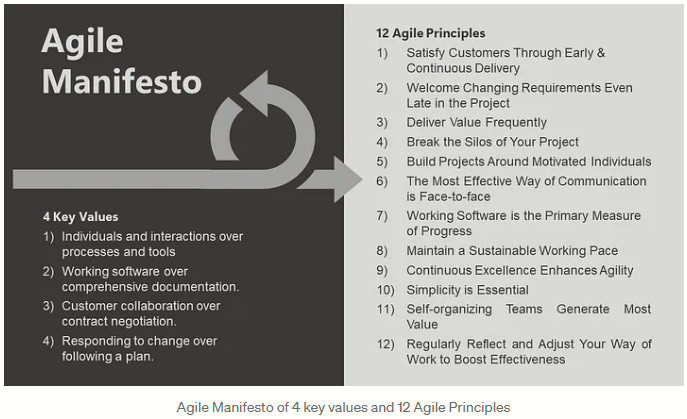The Agile Manifesto: Revisiting Its Core Principles for Modern Times
Agile’s Enduring Relevance in Today’s Fast-Paced World
"The Agile Manifesto's timeless principles of collaboration, flexibility, and customer focus continue to guide teams as they adapt to modern challenges.”
Follow me for more Project Management Insights: LinkedIn | LinkedIn Newsletter
The Agile Manifesto, created in 2001 by 17 software developers, revolutionized how we approach project management. Its core values and principles have since spread far beyond software development and are now applied to various projects across various industries. The emphasis on flexibility, collaboration, and delivering customer value resonates strongly in today’s rapidly changing business environments. But, as industries evolve, so too must Agile. How can we continue to embrace and adapt the Manifesto’s values to meet the demands of modern projects?
In this edition of The PM Playbook, we explore the core principles of the Agile Manifesto and examine their relevance in today’s fast-paced world.
What You’ll Find in This Article:
Understand the core principles of the Agile Manifesto.
Apply Agile in today’s fast-changing environments.
Adapt Agile to various industries and team dynamics.
Enhance collaboration with Agile practices.
Prioritize customer value in disruptive times.
Understanding the Core Principles of the Agile Manifesto
The Agile Manifesto was built around four key values and twelve principles. These focus on prioritizing individuals and interactions over processes and tools, delivering working software over comprehensive documentation, collaborating with customers over negotiating contracts, and responding to change over following a plan. These values continue to be foundational to Agile, but their application in modern times requires flexibility and a broader perspective.
At its core, Agile is about breaking away from rigid, traditional project management methodologies. The principles emphasize delivering value in short cycles, working closely with customers to align the product with their needs, and creating an environment that fosters collaboration. Organizations need to adopt these values as a framework and mindset to truly embrace Agile.
The Core Values of the Agile Manifesto:
Individuals and interactions over processes and tools.
Working software over comprehensive documentation.
Customer collaboration over contract negotiation.
Responding to change over following a plan.
Pro Tip: To apply Agile, start by focusing on team dynamics and collaboration before implementing tools. Technology and processes are important, but they won’t be as effective without a strong team foundation.
Agile in Today’s Rapidly Changing Business Landscape
In today’s business world, agility is more important than ever. The rapid pace of technological advancements, changing customer needs, and market uncertainty require flexibility and quick adaptation. Agile’s focus on iterative progress, flexibility, and stakeholder involvement makes it ideal for navigating this fast-paced environment.
However, Agile principles must be continuously adapted in this constantly changing age. While the foundational values of Agile remain the same, how they are applied in today's environment might look slightly different. Organizations must evaluate how their projects align with Agile principles and determine the best practices to ensure success.
Adapting Agile to Modern Challenges:
Focus on delivering small, incremental improvements.
Embrace feedback loops to ensure customer needs are met continuously.
Incorporate flexibility to pivot quickly based on market or customer feedback.
Align teams with clear goals while fostering adaptability.
Pro Tip: Conduct regular reviews of your Agile processes to ensure they are still relevant to the project’s current needs. Agile is not a “set it and forget it” methodology; it needs continuous improvement to remain effective.
Adapting Agile to Different Industries and Teams
While Agile originated in software development, its principles are now applied in healthcare, marketing, and finance industries. However, the nature of Agile must be adapted depending on the team and industry. Each industry and department may have different priorities and constraints, requiring a tailored approach to the Agile methodology.
For instance, Agile must balance flexibility and regulatory requirements in industries like healthcare or construction, where compliance and documentation are critical. Agile can be leveraged in marketing to test campaigns iteratively and improve them based on customer feedback. The key to success in these industries is recognizing where Agile principles overlap with industry-specific needs and adapting them accordingly.
Tailoring Agile to Specific Industries:
Healthcare: Focus on balancing regulatory requirements with iterative feedback.
Finance: Use Agile to adapt quickly to market changes while adhering to compliance.
Marketing: Apply Agile to create tested and refined campaigns in real-time.
Manufacturing: Adapt Agile to drive continuous improvements in production processes.
Pro Tip: Regularly assess how Agile is being applied within your industry to ensure alignment with current standards and customer needs. Stay flexible in your approach and be open to modifying your Agile practices based on feedback and results.
Enhancing Collaboration Through Agile Practices
Collaboration is a key tenet of the Agile Manifesto, emphasizing the importance of people over processes. Agile promotes cross-functional collaboration, encouraging teams to work together towards shared goals. This collaboration is crucial for success in modern projects, where team members may be in different geographical regions or working in different time zones.
To foster collaboration, it's essential to encourage open communication, frequent check-ins, and transparency within teams. Agile provides the framework for this through daily stand-ups, sprint reviews, and retrospectives. These practices ensure that teams are aligned on goals, address obstacles quickly, and work together to find solutions.
Best Practices for Enhancing Collaboration:
Hold daily stand-ups to ensure alignment with project goals.
Use collaborative tools like Slack, Jira, and Trello for real-time updates.
Encourage cross-functional teams to foster diverse skill sets and viewpoints.
Create a culture of open feedback to improve teamwork and processes.
Pro Tip: Use tools that allow real-time collaboration and ensure all team members are on the same page, especially in remote or hybrid environments. These tools should promote transparency and facilitate communication across departments.
Prioritizing Customer Value in an Era of Disruption
The Agile Manifesto emphasizes the importance of customer collaboration, but this is even more critical in today’s environment of constant disruption. Customer needs are evolving faster than ever, and businesses must be able to respond quickly to changes in demand, preferences, and expectations. Agile allows organizations to stay close to their customers by delivering minor, incremental improvements informed by ongoing feedback.
To prioritize customer value, teams must continuously engage with their customers, ensuring that the product or service evolves according to their needs. This requires shifting focus from simply meeting specifications to solving real customer problems in real-time. Agile teams must also be ready to pivot when needed, responding quickly to feedback and incorporating it into their product development.
How to Prioritize Customer Value:
Conduct regular customer feedback sessions to understand their pain points.
Implement user stories that focus on solving customer problems.
Prioritize features based on customer impact rather than internal desires.
Use data to drive decisions and refine the product.
Pro Tip: Involve customers early and often in the product development process. Their feedback can guide the team toward meaningful changes and ensure the product is aligned with real-world needs.
Agile for Remote and Hybrid Work Environments
The rise of remote and hybrid work environments presents unique challenges for Agile teams. One of the core principles of Agile is face-to-face communication, which can be challenging when team members are scattered across different locations. However, Agile can thrive in remote settings if organizations adopt the right tools and practices.
Agile teams in remote environments must rely heavily on digital tools for collaboration and communication. Regular virtual stand-ups, sprint planning meetings, and retrospectives are key for maintaining alignment. It’s essential to foster a sense of camaraderie and ensure that team members feel connected despite the physical distance.
Implementing Agile in Remote or Hybrid Teams:
Use video conferencing tools like Zoom or Microsoft Teams for regular check-ins.
Implement collaboration tools like Jira or Confluence for real-time updates.
Ensure that teams have the necessary technology to work effectively.
Foster an inclusive culture where all team members are engaged.
Pro Tip: Schedule regular “virtual coffee chats” or informal meetings to build relationships within remote teams. These interactions help build trust and encourage open communication among team members.
Measuring Success and Refining Agile Practices Over Time
Agile is an iterative process, and so is measuring its success. The key to sustaining an Agile culture is regularly evaluating how well it’s working and making adjustments as needed. Teams can continuously improve their processes and outcomes by tracking key metrics, gathering feedback, and conducting retrospectives.
Measuring success in Agile is not just about hitting project milestones; it’s about ensuring the team works efficiently, delivers customer value, and improves over time. Success metrics should be tied to process improvements and tangible outcomes, such as customer satisfaction and product quality.
Key Metrics to Measure Agile Success:
Lead time and cycle time to assess efficiency.
Customer satisfaction scores to measure value delivered.
Team velocity to monitor progress.
Retrospective feedback to identify areas for improvement.
Pro Tip: Regularly review quantitative and qualitative metrics to get a complete picture of Agile performance. Don’t just focus on output—look at how effectively the team is responding to change and collaborating with stakeholders.
Final Thoughts
The Agile Manifesto laid the groundwork for a transformation in project management that is still relevant today. As industries and teams evolve, the core principles of Agile—collaboration, flexibility, and customer value—remain foundational.
Follow me for more Project Management Insights: LinkedIn | LinkedIn Newsletter





